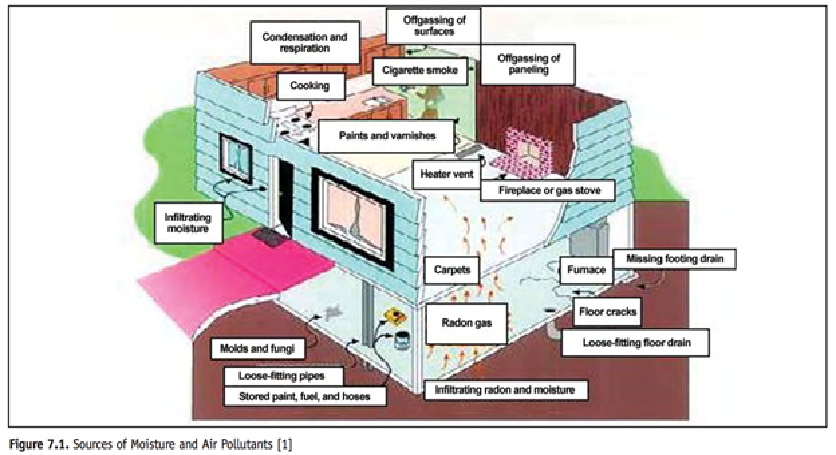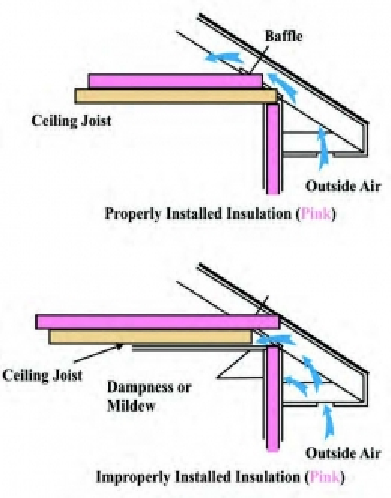Understanding moisture intrusion will help you prevent it and costly damage. Moisture damage is not just from the outside of the home, it can be created inside the home as well. Moisture is created by many ways like breathing; burning candles; washing and drying clothes; using fireplaces, gas stoves, furnaces, humidifiers, and even your air conditioner. There can also be leaks from plumbing or condensation building up on the plumbing. Sometimes, we do not know it is happening until there is damage or even mold growth.
The image below (courtesy of InterNACHI©) shows a few ways moisture gets into your home.

To figure out moisture problems is an often time-consuming and can get expensive process. The thing to do is to is find the areas of moisture problems, and list them in easiest to fix (least expensive) to hardest to fix (most expensive). Take care of the lease expensive first then focus on the hardest. Sometimes, with leaky basements the only thing that needed to be done was to make sure that the sump pump and gutters/downspouts were installed and working correctly. Sometimes, however, you will need to repair a foundation which can be very costly if excavation is required; only a professional can give you the appropriate advice.
Moisture can occur all year round. Here are some factors that increase the probability of this happening:
· Homes that are not properly insulated and are not sealed properly can cause major moisture problems in cold climates.
· Cold interior surfaces can result in the moisture buildup from condensation. If the surface is cold enough to reach the dew point, moisture in the air will condense on the surface and can cause water damage or increase the likelihood of mold growth.
· Dehumidifiers should be used anywhere where the humidity levels reach 80%, many have tanks that collect the water; they need to be emptied and cleaned on a regular basis to prevent the growth of mold and bacteria. It is better if the dehumidifier is draining into a plumbed drain with a trap, like your floor drain in your basement, or a sink. The optimal levels are 30-50% humidity.
· Vents from your dryer, kitchen and bathroom should be cleaned regularly. Clogged vents or filter can trap moisture which will lead to mold or bacteria.
· Lack or proper air exchange (stale air)
The roof, or the umbrella of the home:
Moisture control is extremely important, and it starts with the design and integrity of your roof. There are different types of roofing materials, each with their strengths and weaknesses. Some last a long time, and some do not. All roofs have this in common:
· Must be able to shed moisture
· Protect the interior from the environment
Attic insulation and air flow:
When we build a home, it has the be able to breath (either naturally or mechanically). We do not want to trap air inside the home, because it will trap pollutants in the home and humidity. Moisture buildup leads to mold and bacteria growth, damage to interior finishes, damage to structural components.
For now, I am going to focus on the attic space. The attic space (not to be used for storage) needs to be ventilated. A properly vented attic space has unobstructed soffits (located under the eaves) which allows outside air to move up into the attic space and roof vents which allows the air inside the attic outside.
If for example the insulation in the attic is too thick or was not installed properly; they may obstruct the soffit vents and this could restrict the airflow. Moisture will become trapped in the attic space which will lead to the growth of mold or bacteria, damage insulation and structural components.

Exterior walls and coverings, or your
home’s jacket:
Like a great jacket, your siding should be
attractive, tough, insect and vermin-resistant, UV protected, but most
importantly waterproof, and in some parts of North America where wildfires are
common – fire-resistant.
Sadly, like your well-worn jacket, exterior
siding deteriorates. Materials deteriorate. It is important to walk around your
home once a year and really take a look at the walls, the doors and frames,
windows, looking for any damage that may not have been observed in the past (deterioration
of materials such as siding, brickwork, caulking, wood, concrete, etc.). Do not
forget to check the collar (the gutters); gutters need to be cleaned at least
once a year, damage and leaks should be addressed immediately.
Downspouts should discharge 1.8m from your
home (6’)
The exterior walls can be composted of a
few different types of coverings, and I will be covering the most common ones
in the Ottawa area.
Brick is one of the types you will see
around Ottawa (and other locations) – at first glace you would think that it is
nearly maintenance free. Sometimes this is true, sometimes it is not – brick
will degrade overtime and needs to be inspected and repaired as needed. There
are two types of brick homes – masonry brick homes where the exterior brick
work is supported part of the weight of the home, and more commonly found in
newer construction veneer brick walls which is a thin set of brick outside the
wooden stud wall – the brick is not supporting the weight of the home.
Synthetic stucco (also known as exterior
insulation and finishing system; EIFS) has been around in Europe since the end
of World War II, although it only started to be used in North America in the
1980s making it’s debut on commercial buildings and then making it’s way to
wood framed houses.
EIFS is made up of three layers:
·
The inner layer which is foam insulation
board secured to the exterior wall surface, usually with an adhesive.
·
The middle layer which is a
polymer and cement base coat applied to the top of the insulation and
reinforced with a fiber glass mess.
·
And the exterior layer which is
a textured finish.
EIFS does not breath. What this means is
that if moisture enters the layers which can lead to deterioration of the EIFS
and worse off, rot of structural wall components. EIFS can be damaged easily
and should be repaired immediately.
Vinyl siding are flexible sheets of plastic
that formed and coloured during manufacturing; they are also designed to
interlock with each other. Vinyl siding should be secured loosely because they
expand and contract. It is for the reason contraction and expansion that also
cutting the siding appropriately is important, even the smallest cracks
exposing the undersurface can result in major damage.
Metal siding must be installed with compatible
fasteners, if the metal siding and the screws and nails are incompatible, the siding
and/or fasteners will begin to corrode because of galvanic response.
When we have two different metals, for
example aluminum and steel and add a corrosive environment (air, water, salt
spray, cleaning solutions) the more active metal, in this case aluminum, will
become what is known as an anode and begins to corrode through exfoliation or
pitting. This can happen anywhere there are dissimilar metals including but not
limited to plumbing, roofing, siding, gutters, metal venting, and HVAC systems.
Fall is right around the corner, now would
be a great time to really take a look around the exterior of your home and make
sure it’s ready for next spring!

